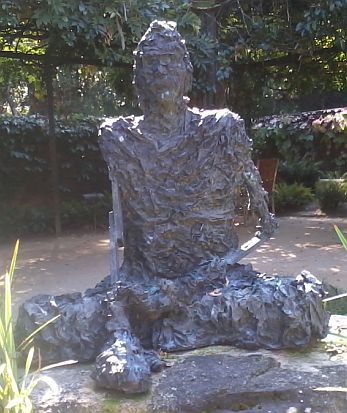|
He is Iron Buddha - at least that's how I refer to him. It isn't until later, quite a while later in fact, I find out he's actually cast in bronze not in iron. So he's actually Bronze Buddha not Iron Buddha after all. It hardly matters. Whatever metal he's cast in, he's riveting, sitting here on this rock in eternal Zazen. Yet in honor of the metal in which his creator did cast him, I've titled this essay (and am referring to him as) Bronze Buddha.
His first nuance which grabs at my heart when I notice it, is oh so subtlely different than most renditions of Buddha. Most Buddhas have the palm of their right hand open and up (fulfilled) and the palm of their left hand open and down (accepting). And both this Buddha's palms are so roughly hewn that it's hard to tell whether they're open or closed. That's not what gets my attention. What gets my attention is what you can tell: his left hand is resting on his crossed legs, and his right hand is touching the ground, the Earth. Now I get who he is: he's the Earth‑touching Buddha. Oh ... my ... God! How subtle. How sublime. How perfect!
Listen: it's not easy to create a true representation of the Self (you try it) - which is what this Bronze Buddha is. It's actually a whole lot easier to create / be the Self itself (which isn't easy to create / be either) than it is to create a true working representation of the Self. So to sculpt a true working representation of the Self like this Bronze Buddha, is another exponential order of creation entirely, one which requires a very special talent.
What's stunning about this work and his presentation as I be with him on this rock under these shady redwoods, is getting his true working representation of the Self in the world, and I get it's me as the Self getting his true working representation of the Self in the world, and I get he and I and the world all show up in the context of the eternal Self. It's a Zazen home run. I sit down before him and, ignoring the caramel colored gravel on the ground staining and embedding into the backside fabric of my black jeans, cross my legs like him, rest my left hand on my crossed legs like him, touch the Earth with my right hand in front of me like him, and just stare at him. He stares straight back at me, his gaze unwavering, this Earth-touching Buddha, our good friend.
